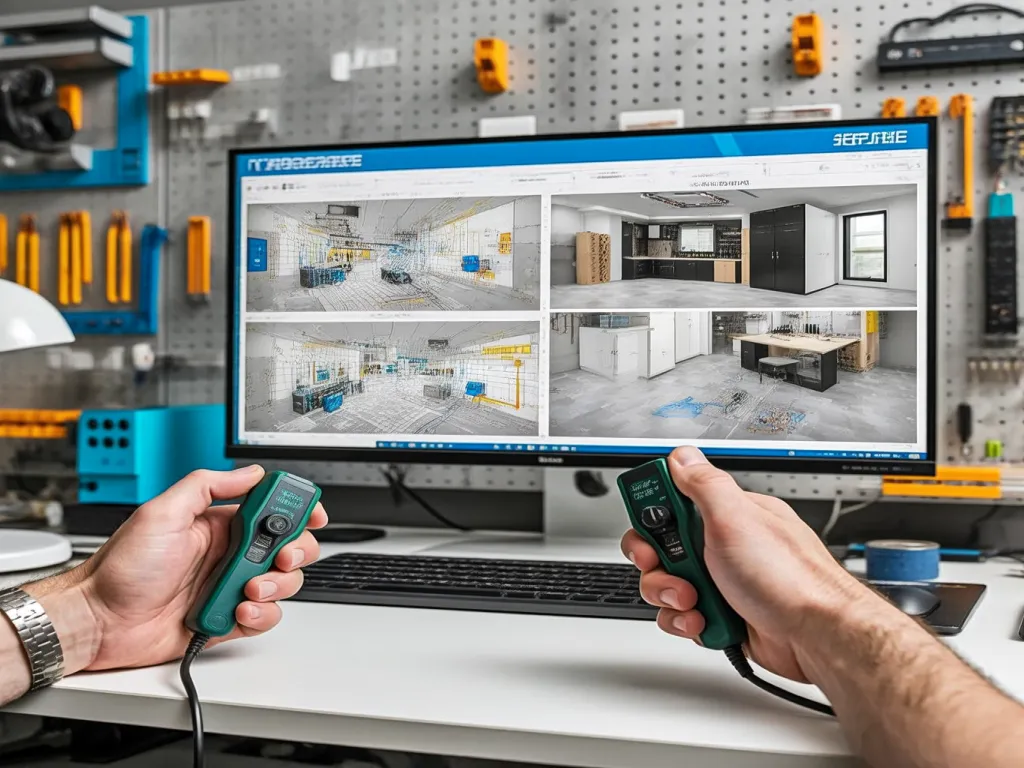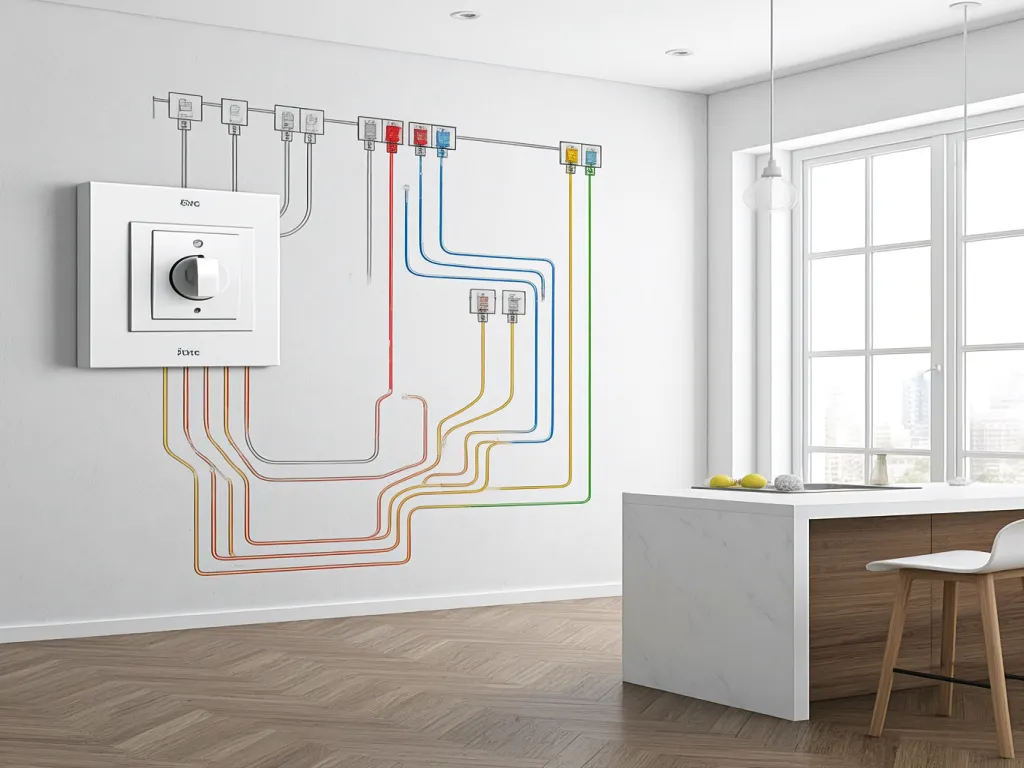Dual-Scene Mastery: 3 Pin Rocker Switch Wiring Guide
Navigating the complexities of electrical systems across industrial controls and home appliances? The key to seamless integration lies in understanding the 3 pin rocker switch wiring diagram. Whether you’re engineering robust machinery or designing user-friendly household gadgets, getting the wiring right is crucial. This guide dives deep into tailored solutions for both scenarios, plus a universal design that bridges the gap. Ever wondered how a single diagram could revolutionize your project’s efficiency? Let’s unravel the mystery together.

Industrial Control Scenario Wiring Diagram Design: High Demands for Stability, Durability, and Anti-Interference Capabilities
When it comes to industrial control environments, the demands placed on switches—especially 3 pin rocker switches—are significantly higher than those in typical consumer settings. Why? Because industrial applications often involve harsh conditions, continuous operation, and exposure to electromagnetic interference (EMI) that can disrupt even the most robust electronic components. If you’re designing or selecting a wiring diagram for a 3 pin rocker switch in an industrial setting, you need to prioritize three key factors: stability, durability, and anti-interference capabilities. Let’s break down each one and explore how to choose a wiring diagram that meets these stringent requirements.
First up: stability. In industrial control systems, a momentary loss of power or an incorrect signal can lead to catastrophic failures, from equipment damage to safety hazards. That’s why your wiring diagram must ensure a rock-solid connection between the switch and the controlled device. One way to achieve this is by using a metal-encased 3 pin rocker switch. Metal casings not only provide physical protection against impact and vibration but also act as a natural shield against EMI. When designing your diagram, make sure the metal casing is properly grounded to divert any stray electrical noise away from sensitive circuits.
Next, durability. Industrial environments are tough on electronics. Temperature fluctuations, humidity, dust, and chemicals can all degrade components over time. A wiring diagram that incorporates durable materials and construction techniques is essential. For example, choose a switch with gold-plated contacts. Gold resists corrosion and maintains a consistent electrical connection even after thousands of cycles. If you’re looking for a reliable 3-pin rocker switch with such features, consider exploring our KCD1 rocker switch, which offers gold-plated contacts for enhanced durability. Additionally, consider a diagram that includes weatherproofing features, such as silicone gaskets or epoxy potting, to seal out moisture and contaminants.
Now, let’s talk about anti-interference capabilities. Industrial settings are rife with EMI sources—motors, relays, power supplies, and even wireless devices can generate electrical noise that interferes with switch operation. A well-designed wiring diagram should include measures to mitigate EMI. One effective technique is to add a filter circuit between the switch and the load. A simple RC (resistor-capacitor) filter can smooth out voltage spikes and reduce high-frequency noise. For more severe interference, consider a ferrite bead or a dedicated EMI filter module. When laying out your diagram, keep signal traces as short as possible and avoid running them parallel to power lines to minimize coupling effects.
You might be wondering: ‘How do I balance all these requirements without overcomplicating the design?’ The answer lies in choosing a wiring diagram that integrates these protective features seamlessly. For instance, a diagram that specifies a metal-cased switch with built-in EMI filtering and gold-plated contacts offers a turnkey solution for industrial control applications. By selecting such a diagram, you’re not just drawing lines on paper—you’re engineering a system that can withstand the rigors of the factory floor.
In practice, this means collaborating closely with switch manufacturers who understand industrial requirements. Many suppliers offer pre-certified wiring diagrams tailored for specific applications, saving you time and reducing the risk of errors. When reviewing these diagrams, ask questions like: ‘Has this design been tested under real-world industrial conditions?’ ‘Does it comply with relevant standards like IEC 61010 or UL 508?’ A supplier that can provide test reports and compliance certificates is a valuable partner in your design process.
Ultimately, the goal is to create a wiring diagram that’s as rugged as the environment it operates in. By focusing on stability, durability, and anti-interference capabilities, you’ll ensure your 3 pin rocker switch performs reliably, year after year, in even the most demanding industrial settings. So, are you ready to elevate your industrial control designs with a wiring diagram that truly delivers?

The Role of Metal Casings in Stability
Metal casings aren’t just for aesthetics—they’re a critical component of switch stability in industrial environments. The rigid structure of a metal enclosure prevents physical deformation that could misalign contacts or break solder joints. Moreover, metal acts as a Faraday cage, blocking external EMI from reaching the switch’s internal circuitry. When selecting a wiring diagram, verify that the metal casing is properly rated for your application’s voltage and current levels. Some diagrams may even specify a particular alloy (e.g., aluminum or stainless steel) based on its thermal conductivity or corrosion resistance.
Durability Through Material Selection
Choosing the right materials for your switch and wiring diagram can make or break its longevity. Beyond gold-plated contacts, consider the switch’s housing material. Polycarbonate is a popular choice for its impact resistance and flame retardancy, but in extremely harsh environments, you might opt for a metal-polymer hybrid. For switches that need to withstand even more extreme conditions, consider exploring our 4-pin KCD2 rocker switch, which is designed for robust performance. The wiring itself should use stranded copper conductors, which flex without breaking, rather than solid wire. Additionally, specify heat-shrink tubing or convoluted tubing for wire protection in areas prone to abrasion.
Advanced Anti-Interference Techniques
For applications near high-power equipment, basic filtering may not suffice. Advanced techniques include shielded cables, where a conductive layer surrounds the signal wires to block EMI, and optical isolation, which uses light to transmit signals between circuits, eliminating electrical coupling. Some industrial wiring diagrams even incorporate real-time monitoring of EMI levels, triggering alarms or fail-safes if interference exceeds safe thresholds. While these features add complexity, they’re invaluable in mission-critical systems where downtime is unacceptable.

Home Appliance Scenario Wiring Diagram Design: Safety, Usability, and Aesthetics in Switch Selection
First off, safety is non-negotiable.
Home appliances are used daily by people of all ages, including children and the elderly. A wiring diagram that prioritizes safety means clearly indicating which terminals are for live, neutral, and ground connections. Using color-coded wires—like red for live, blue for neutral, and green/yellow for ground—is a simple yet effective way to reduce the risk of incorrect wiring. Imagine trying to install a switch in a dimly lit kitchen; a color-coded diagram ensures you connect the right wire to the right terminal, even if you’re not an electrician. For switches like the KCD7 6A 250V rocker switch, adhering to such safety standards is crucial.
Next up, usability.
Ever tried assembling furniture without clear instructions? Frustrating, right? The same goes for wiring a 3 pin rocker switch. A diagram with a logical, easy-to-follow layout minimizes confusion. For instance, placing the live terminal at the top, neutral in the middle, and ground at the bottom aligns with common electrical practices, making it intuitive for users. Additionally, labeling each terminal with its function (L for live, N for neutral, E for earth) further simplifies the process. This isn’t just about making installation easier; it’s about empowering users to maintain and troubleshoot their appliances confidently. Consider switches like the KCD3-11 6A 250V mini rocker switch, which can benefit from such user-friendly diagrams.
Now, let’s talk aesthetics.
Yes, even wiring diagrams can be aesthetically pleasing! In home appliances, the switch is often a visible component. A cluttered or poorly designed diagram can make the entire appliance look unprofessional. A clean, well-organized diagram with clear lines and minimal text clutter enhances the overall appearance. Some manufacturers even go a step further by integrating the diagram into the appliance’s design, using a subtle color scheme that complements the product’s aesthetics. This attention to detail shows that the manufacturer cares about every aspect of the user experience, not just the functionality. For example, the IP44 6A 250V mini rocker switch could feature a diagram that seamlessly blends with its design.
But how do you create such a diagram?
Start by understanding the user’s perspective. What would make the installation process smoother for them? Use visual cues like arrows to indicate the flow of current or icons to represent different components. Avoid jargon; instead, use plain language that anyone can understand. For example, instead of saying ‘connect the phase wire to terminal 1,’ say ‘attach the red wire to the top terminal.’ Testing the diagram with real users can also provide valuable feedback. Have someone with no electrical background try to wire the switch using your diagram. If they can do it correctly on the first try, you’re on the right track. For switches like the 2A 250V white SPST rocker switch, such user-centric design is essential.
In conclusion,
designing a 3 pin rocker switch wiring diagram for home appliances is about more than just technical accuracy. It’s about creating a safe, user-friendly, and visually appealing guide that empowers users to install and maintain their appliances with confidence. By prioritizing color coding, logical layout, and clear labeling, you can ensure that your wiring diagram meets these standards. So, the next time you’re designing a wiring diagram, ask yourself: does this make the user’s life easier? If the answer is yes, you’ve done your job well.

Cross-Scenario Universal Wiring Solution: Introducing a 3-Pin Rocker Switch Diagram for Both Industrial Control and Home Appliances
Have you ever found yourself struggling to manage two separate wiring diagrams—one for industrial control systems and another for home appliances? The challenge is real, especially when you’re trying to streamline operations, reduce inventory costs, and simplify the learning curve for your team. What if I told you there’s a solution that merges both worlds seamlessly? Let’s dive into a cross-scenario universal wiring diagram for 3-pin rocker switches that does just that.
The core idea behind this universal design is modularity. Instead of creating two distinct diagrams, we’ve engineered a single, adaptable solution that can be easily modified to suit either industrial or home appliance environments. How does this work? At its foundation, the diagram features a standardized 3-pin layout with clearly labeled terminals: common (COM), normally open (NO), and normally closed (NC). These are the building blocks of any rocker switch, but here’s where the magic happens.
For industrial control applications, the diagram includes optional modules that can be added to enhance durability and resistance to environmental factors. For instance, you might incorporate a heavy-duty metal housing module to protect against physical damage or electromagnetic interference (EMI) shielding to prevent signal disruption. These modules are designed to ‘plug in’ to the base diagram, much like adding accessories to a smartphone. This way, you’re not redesigning the entire circuit; you’re simply enhancing it where needed. For those seeking reliable components, consider exploring options like the IP65 waterproof rocker switch, which offers robust protection against environmental elements.
On the flip side, when adapting the same diagram for home appliances, you can focus on user-friendly features. Imagine a color-coded wiring guide that makes installation a breeze for DIY enthusiasts or technicians. The diagram could highlight safety zones, such as low-voltage areas, and include visual cues for proper grounding. By keeping the core 3-pin structure intact, manufacturers can produce a single type of switch and customize its documentation or additional components based on the end use. For instance, a KCD3 6A 250V IP65 waterproof rocker switch could be ideal for home appliances requiring both durability and user-friendliness.
But why stop at just two scenarios? The beauty of this modular approach is its scalability. Whether you’re dealing with medical equipment, automotive systems, or even outdoor lighting, the base diagram remains consistent. You only need to adjust the peripheral elements—the modules—to meet specific regulatory standards or environmental conditions. This reduces the need for multiple SKUs in your inventory, cutting down on storage costs and minimizing the risk of ordering errors. For example, a 2-pin waterproof rocker switch could be adapted for outdoor lighting systems with minimal modifications.
Let’s talk about the learning curve. Training employees to understand one universal diagram is far more efficient than teaching them several variations. With this system, new hires can quickly grasp the fundamentals and then learn how to customize the setup for different applications. It’s like learning to drive a car; once you know the basics, adapting to different models becomes second nature.
From a financial perspective, the savings are substantial. Consider the cost of designing, printing, and storing multiple wiring manuals. Now imagine having just one comprehensive guide that covers all bases. Not to mention the reduced likelihood of production delays caused by misinterpreted or misplaced diagrams. For bulk purchases, options like the KCD5 6A 250VAC rocker switch can further streamline costs and inventory management.
You might be wondering, ‘Does this compromise on quality or safety?’ Absolutely not. Each module is rigorously tested to ensure it meets the highest standards for its intended use. The base diagram itself adheres to universal electrical codes, providing a solid foundation that doesn’t cut corners.
In practice, let’s say you’re manufacturing both industrial machinery and smart home devices. With this universal diagram, your engineering team can collaborate more effectively, sharing insights across departments. Your supply chain benefits from fewer part numbers to manage, and your customers appreciate the consistency in product documentation.
So, are you ready to revolutionize your approach to 3-pin rocker switch wiring? By embracing this cross-scenario design, you’re not just saving time and money—you’re future-proofing your operations against the ever-evolving demands of technology and market trends.
Selecting the optimal 3 pin rocker switch wiring diagram is pivotal for achieving peak performance across diverse applications. From industrial environments demanding ruggedness to home electronics prioritizing safety and aesthetics, this guide equips you with the knowledge to make informed decisions. The cross-scenario solution we’ve explored simplifies inventory management and accelerates learning curves. Ready to elevate your project’s reliability and user experience? Dive deeper into our recommended resources and start implementing the perfect wiring solution today. What other electrical challenges could a versatile diagram solve for you?

